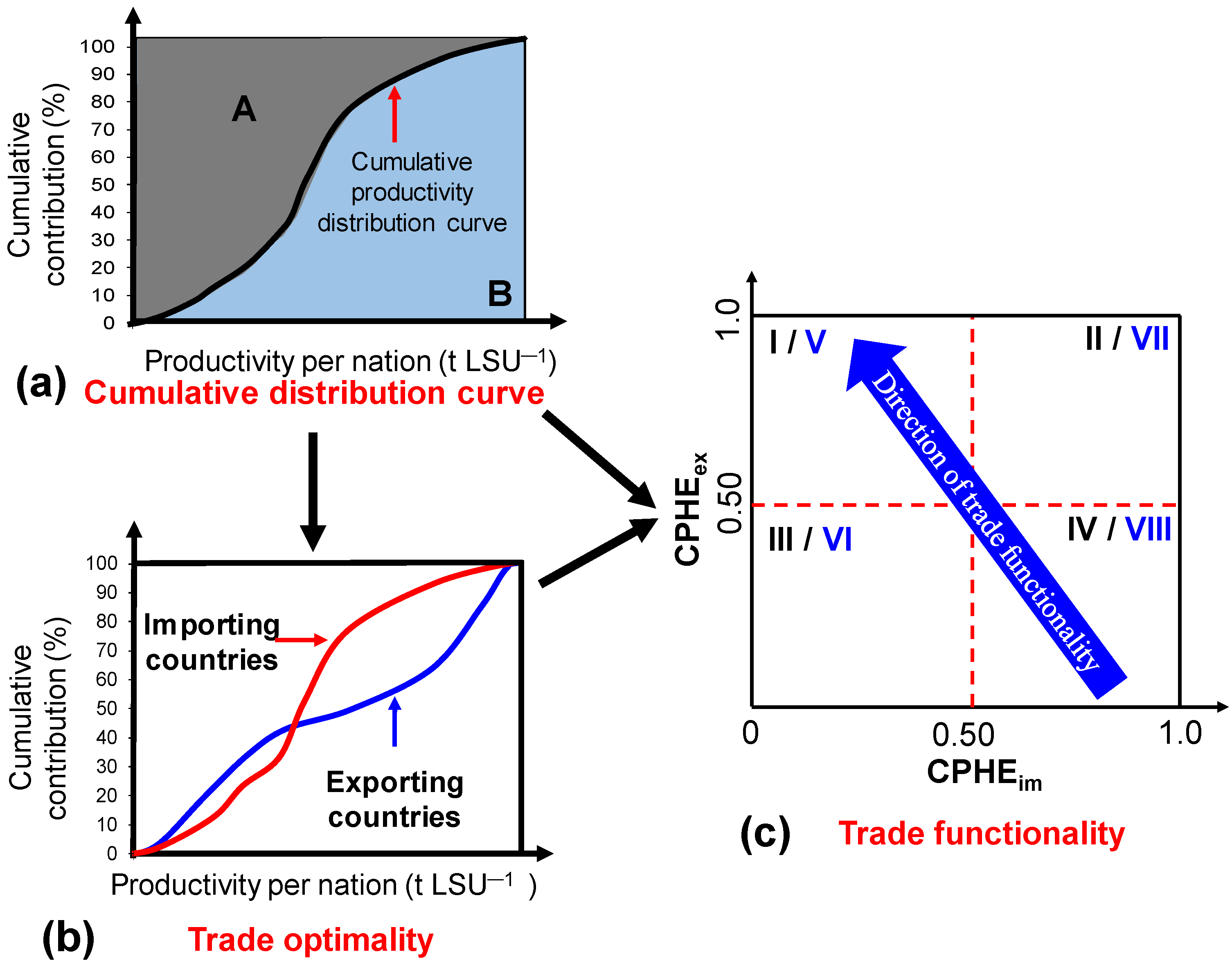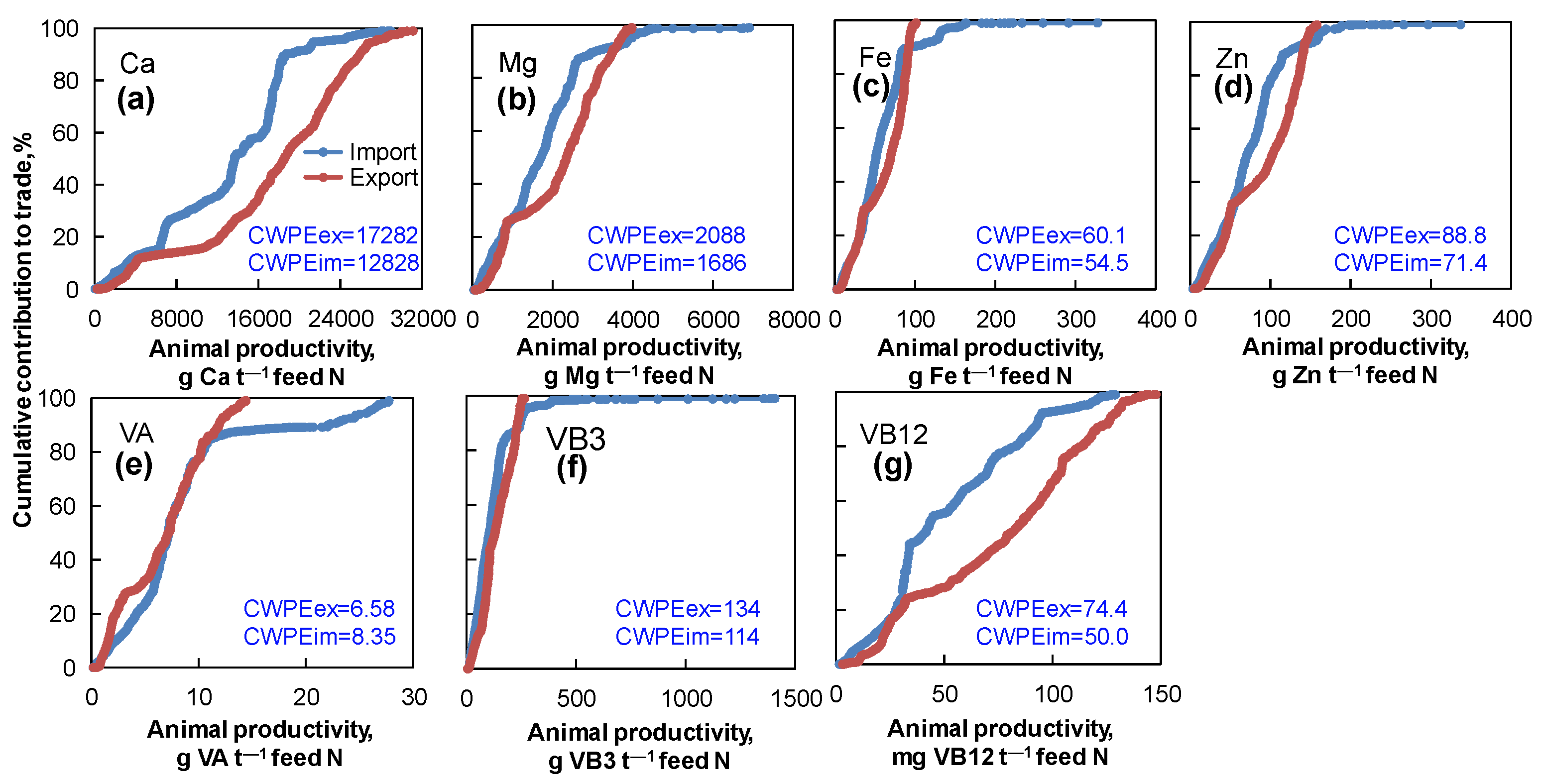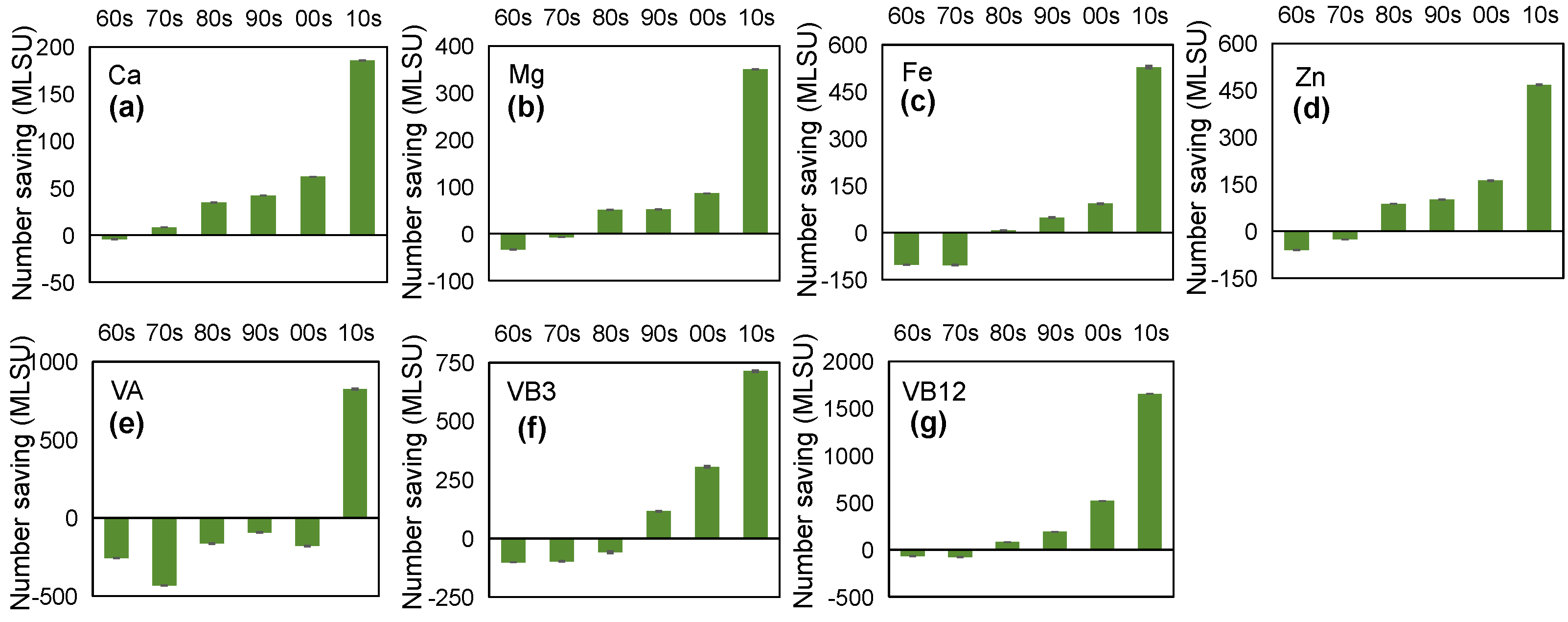Does the Trade of Livestock Products Enhance Micro-Nutrient Availability While Minimizing Environmental Impact?
Abstract
:1. Introduction
2. Material and Methods
2.1. Trade of Livestock Products and Micro-Nutrient Contents
2.2. The Micro-Nutrient Productivity of Livestock Production
2.3. The Cumulative Distribution Curve of Livestock Production
2.4. Trade Optimality and Functionality Analytic Farmwork
2.5. Potential Impacts on Livestock Productivity and Feed N Use
3. Results and Discussion
3.1. Impacts of Trade on the Micro-Nutrient Production per Livestock Unit
3.2. Impacts of Trade on the Micro-Nutrient Production per Feed N Input
3.3. Potential Increase or Reduction in Livestock Units through Trade
3.4. Potential Increase or Reduction in Feed N through Trade
3.5. Changes in Trade Optimality and Functionality
3.6. Future Implications
Limitations
4. Conclusions
Supplementary Materials
Author Contributions
Funding
Data Availability Statement
Acknowledgments
Conflicts of Interest
References
- Malnutrition Data (UNICEF, WHO & World Bank, 2021). Available online: https://data.unicef.org/resources/dataset/malnutrition-data/ (accessed on 29 April 2024).
- Swinburn, B.A.; Kraak, V.I.; Allender, S.; Atkins, V.J.; Baker, P.I.; Bogard, J.R.; Brinsden, H.; Calvillo, A.; De Schutter, O.; Devarajan, R.; et al. The global syndemic of obesity, undernutrition, and climate change: The Lancet Commission report. Lancet 2019, 393, 791–846. [Google Scholar] [CrossRef]
- Caulfield, L.E.; Richard, S.A.; Rivera, J.A.; Musgrove, P.; Black, R.E. Stunting, wasting, and micronutrient deficiency disorders. In Disease Control Priorities in Developing Countries; Jamison, D.T., Breman, J.G., Measham, A.R., Alleyne, G., Claeson, M., Evans, D.B., Jha, P., Mills, A., Musgrove, P., Eds.; Ch. 28; The International Bank for Reconstruction and Development/The World Bank & Oxford University Press: Washington, DC, USA, 2006. [Google Scholar]
- Wang, X.; Dou, Z.; Feng, S.; Zhang, Y.; Ma, L.; Zou, C.; Bai, Z.; Lakshmanan, P.; Shi, X.; Liu, D.; et al. Global food nutrients analysis reveals alarming gaps and daunting challenges. Nat. Food 2023, 4, 1007–1017. [Google Scholar] [CrossRef]
- Dror, D.K.; Lindsay, A. The importance of milk and other animal-source foods for children in low-income countries. Food Nutr. Bull. 2011, 32, 227–243. [Google Scholar] [CrossRef]
- Headey, D.; Hirvonen, K.; Hoddinott, J. Animal sourced foods and child stunting. Am. J. Agric. Econ. 2018, 100, 1302–1319. [Google Scholar] [CrossRef] [PubMed]
- Zaharia, S.; Ghosh, S.; Shrestha, R.; Manohar, S.; Thorne-Lyman, A.L.; Bashaasha, B.; Kabunga, N.; Gurung, S.; Namirembe, G.; Appel, K.H.; et al. Sustained intake of animal-sourced foods is associated with less stunting in young children. Nat. Food 2021, 2, 246–254. [Google Scholar] [CrossRef]
- Pimpin, L.; Kranz, S.; Liu, E.; Shulkin, M.; Karageorgou, D.; Miller, V.; Fawzi, W.; Duggan, C.; Webb, P.; Mozaffarian, D. Effects of animal protein supplementation of mothers, preterm infants, and term infants on growth outcomes in childhood: A systematic review and meta-analysis of randomized trials. Am. J. Clin. Nutr. 2019, 110, 410–429. [Google Scholar] [CrossRef] [PubMed]
- Chungchunlam, S.M.S.; Moughan, P.J.; Garrick, D.P.; Drewnowski, A. Animal-sourced foods are required for minimum-cost nutritionally adequate food patterns for the United States. Nat. Food 2020, 1, 376–381. [Google Scholar] [CrossRef]
- Mottet, A.; Haan, C.; Falcucci, A.; Tempio, G.; Opio, C.; Gerber, P. Livestock: On our plates or eating at our table? A new analysis of the feed/food debate. Glob. Food Secur. 2017, 1, 1–8. [Google Scholar] [CrossRef]
- Webb, J.; Menzi, H.; Misselbrook, T.H.; Dämmgen, U.; Hendriks, H.; Döhler, H. Managing ammonia emissions from livestock production in Europe. Environ. Pollut. 2005, 135, 399–406. [Google Scholar] [CrossRef]
- Bai, Z.; Ma, L.; Jin, S.; Ma, W.; Velthof, G.; Oenema, O.; Liu, L.; Chadwick, D.; Zhang, F. Nitrogen, phosphorus, and potassium flows through the manure management chain in China. Environ. Sci. Technol. 2016, 50, 13409–13418. [Google Scholar] [CrossRef]
- Uwizeye, A.; de Boer, I.J.; Opio, C.I.; Schulte, R.P.; Falcucci, A.; Tempio, G.; Teillard, F.; Casu, F.; Rulli, M.; Galloway, J.N.; et al. Nitrogen emissions along global livestock supply chains. Nat. Food 2020, 1, 437–446. [Google Scholar] [CrossRef]
- Crippa, M.; Solazzo, E.; Guizzardi, D.; Monforti-Ferrario, F.; Tubiello, F.N.; Leip, A. Food systems are responsible for a third of global anthropogenic GHG emissions. Nat. Food 2021, 2, 198–209. [Google Scholar] [CrossRef] [PubMed]
- Xu, X.; Sharma, P.; Shu, S.; Lin, T.; Ciais, P.; Tubiello, F.N.; Smith, P.; Campbell, N.; Jain, A.K. Global greenhouse gas emissions from animal-based foods are twice those of plant-based foods. Nat. Food 2021, 2, 724–732. [Google Scholar] [CrossRef] [PubMed]
- Liu, K.; Ma, R.; Yan, K.; Zhang, B.; Xu, S.; Feng, C. Tracing global N2O emission mitigation strategies through trade networks. J. Environ. Manag. 2023, 344, 118455. [Google Scholar] [CrossRef] [PubMed]
- Wang, X.; Qiang, W.; Liu, X.; Yan, S.; Qi, Y.; Jia, Z.; Liu, G. The spatiotemporal patterns and network characteristics of emissions embodied in the international trade of livestock products. J. Environ. Manag. 2022, 322, 116128. [Google Scholar] [CrossRef] [PubMed]
- Liu, B.; Feng, K.; Sun, L.; Baiocchi, G. Does interstate trade of agricultural products in the US alleviate land and water stress? J. Environ. Manag. 2024, 354, 120427. [Google Scholar] [CrossRef]
- Bai, Z.; Ma, W.; Zhao, H.; Guo, M.; Oenema, O.; Smith, P.; Velthof, G.; Liu, X.; Hu, C.; Wang, P.; et al. Food and feed trade has greatly impacted global land and nitrogen use efficiencies over 1961–2017. Nat. Food 2021, 2, 780–791. [Google Scholar] [CrossRef]
- Bai, Z.; Liu, L.; Obersteiner, M.; Mosnier, A.; Chen, X.; Yuan, Z.; Ma, L. Agricultural trade impacts global phosphorus use and partial productivity. Nat. Food 2023, 4, 762–773. [Google Scholar] [CrossRef]
- Food and Agriculture Organization of the United Nations (FAO). Available online: https://www.fao.org/faostat/en/#data/domains_table (accessed on 29 April 2024).
- Yang, Y. China Food Composition Tables, 6th ed.; Peking University Medical Press: Beijing, China, 2019; pp. 2–307. (In Chinese) [Google Scholar]
- USDA (U.S. Department of Agriculture). 2023. Available online: https://fdc.nal.usda.gov/fdc-app.html#/?query=Asparagus (accessed on 29 April 2024).
- Liu, Q.; Wang, J.; Bai, Z.; Ma, L.; Oenema, O. Global animal production and nitrogen and phosphorus flows. Soil Res. 2017, 55, 451–462. [Google Scholar] [CrossRef]
- Castanheira, É.G.; Freire, F. Greenhouse gas assessment of soybean production: Implications of land use change and different cultivation systems. J. Clean. Prod. 2013, 54, 49–60. [Google Scholar] [CrossRef]
- Hou, Y.; Velthof, G.; Oenema, O. Mitigation of ammonia, nitrous oxide and methane emissions from manure management chains: A meta-analysis and integrated assessment. Glob. Chang. Biol. 2015, 21, 1293–1312. [Google Scholar] [CrossRef]
- Herrero, M.; Havlík, P.; Valin, H.; Obersteiner, M. Biomass use, production, feed efficiencies, and greenhouse gas emissions from global livestock systems. Proc. Natl. Acad. Sci. USA 2013, 110, 20888–20893. [Google Scholar] [CrossRef]
- Stokstad, E. Nitrogen crisis threatens Dutch environment—And economy. Science 2019, 366, 1180–1181. [Google Scholar] [CrossRef] [PubMed]
- Liu, L. Exploring global changes in agricultural ammonia emissions and their contribution to nitrogen deposition since 1980. Proc. Natl. Acad. Sci. USA 2022, 119, e2121998119. [Google Scholar] [CrossRef]
- Poppy, G.M.; Baverstock-Poppy, J.; Baverstock, J. Trade and dietary preferences can determine micronutrient security in the United Kingdom. Nat. Food 2022, 3, 512–522. [Google Scholar] [CrossRef] [PubMed]
- Wilson, J.D. Mega-regional trade deals in the Asia-Pacific: Choosing between the TPP and RCEP? J. Contemp. Asia 2015, 45, 345–353. [Google Scholar] [CrossRef]
- Bai, Z.; Jin, X.; Oemema, O.; Lee, M.; Zhao, J.; Ma, L. Impacts of African swine fever on water quality in China. Environ. Res. Lett. 2021, 16, 054032. [Google Scholar] [CrossRef]
- Springmann, M.; Kennard, H.; Dalin, C.; Freund, F. International food trade contributes to dietary risks and mortality at global, regional and national levels. Nat. Food 2023, 4, 886–893. [Google Scholar] [CrossRef] [PubMed]
- Geyik, Ö.; Hadjikakou, M.; Bryan, B. Publisher Correction: Climate-friendly and nutrition-sensitive interventions can close the global dietary nutrient gap while reducing GHG emission. Nat. Food 2023, 4, 126. [Google Scholar] [CrossRef]
- Liu, X.; Liang, Y.; Chen, K. Dairy trade liberalization and child stunting: Evidence from low-and middle-income countries. Food Policy 2024, 122, 102554. [Google Scholar] [CrossRef]
- Wu, Y.; Mao, X.; Lu, J.; Wang, M.; Zhang, Q.; Song, P.; Liu, Z.; Gong, W. Dairy Trade Helps to Alleviate Global Carbon Emission Pressure. Environ. Sci. Technol. 2022, 56, 12656–12666. [Google Scholar] [CrossRef] [PubMed]
- Peters, C.J.; Picardy, J.; Darrouzet-Nardi, A.; Griffin, T. Feed conversions, ration compositions, and land use efficiencies of major livestock products in US agricultural systems. Agric. Syst. 2014, 130, 35–43. [Google Scholar] [CrossRef]
- Leip, A.; Billen, G.; Garnier, J.; Grizzetti, B.; Lassaletta, L.; Reis, S.; Simpson, D.; Sutton, M.A.; De Vries, W.; Weiss, F.; et al. Impacts of European livestock production: Nitrogen, sulphur, phosphorus and greenhouse gas emissions, land-use, water eutrophication and biodiversity. Environ. Res. Lett. 2015, 10, 115004. [Google Scholar] [CrossRef]
- Lassaletta, L.; Billen, G.; Grizzetti, B.; Garnier, J.; Leach, A.; Galloway, J. Food and feed trade as a driver in the global nitrogen cycle: 50-year trends. Biogeochemistry 2014, 118, 225–241. [Google Scholar] [CrossRef]







Disclaimer/Publisher’s Note: The statements, opinions and data contained in all publications are solely those of the individual author(s) and contributor(s) and not of MDPI and/or the editor(s). MDPI and/or the editor(s) disclaim responsibility for any injury to people or property resulting from any ideas, methods, instructions or products referred to in the content. |
© 2024 by the authors. Licensee MDPI, Basel, Switzerland. This article is an open access article distributed under the terms and conditions of the Creative Commons Attribution (CC BY) license (https://creativecommons.org/licenses/by/4.0/).
Share and Cite
Liu, X.; Li, Q.; Liu, L.; Bai, Z. Does the Trade of Livestock Products Enhance Micro-Nutrient Availability While Minimizing Environmental Impact? Agriculture 2024, 14, 861. https://doi.org/10.3390/agriculture14060861
Liu X, Li Q, Liu L, Bai Z. Does the Trade of Livestock Products Enhance Micro-Nutrient Availability While Minimizing Environmental Impact? Agriculture. 2024; 14(6):861. https://doi.org/10.3390/agriculture14060861
Chicago/Turabian StyleLiu, Xia, Qianqian Li, Ling Liu, and Zhaohai Bai. 2024. "Does the Trade of Livestock Products Enhance Micro-Nutrient Availability While Minimizing Environmental Impact?" Agriculture 14, no. 6: 861. https://doi.org/10.3390/agriculture14060861




